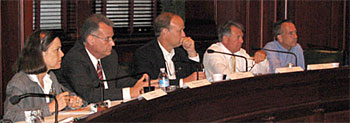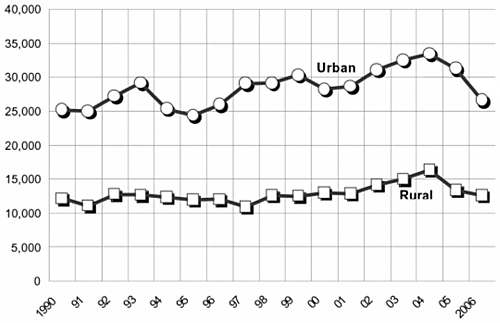Newsletters
- Home
- Publications
- Newsletter Archive
- Newsletter
September/October 2007
Inside This Issue:
- Research Reveals Public’s Low Knowledge of Pennsylvania Agriculture
- Chairman’s Message
- Legislators Participate in Policy Session on Rural Family Economic Success
- School Nurses: Working to Meet the Health Care Needs of Students
- Did You Know. . .
- Act 50’s Impact on Local Taxes
- Fast Fact: Building Permits Issued in Rural and Urban Pennsylvania, 1990 to 2006
- Just the Facts: A Taxing Decision
Research Reveals Public’s Low Knowledge of Pennsylvania Agriculture
Even though the agricultural sector plays a major role in Pennsylvania’s economy, many Pennsylvanians admit they know little about agriculture, according to research sponsored by the Center for Rural Pennsylvania and conducted by faculty at Pennsylvania State University.
The research, which included more than 1,500 Pennsylvanians from 65 counties, also found that many Pennsylvanians admit to knowing little about farming production practices and agriculture and the environment.
Research background
In 2005, Penn State researchers Dr. Fern Willits, Dr. A.E. Luloff, and Dr. Jennifer James surveyed 1,521 Pennsylvanians in every county, except Philadelphia and Allegheny counties, to determine their knowledge of and perceptions about agriculture in the state. The study looked to assess how much Pennsylvanians know about agriculture, to understand how personal characteristics and frequency of rural visits related to agricultural knowledge, and to explore the relationship of agricultural knowledge to public perceptions of selected agricultural issues. The research also looked to understand how information on Pennsylvanians’ knowledge, experiences, and perceptions of agriculture are relevant to policymakers.
Results reveal uncertainties
Overall, the study results showed that most participants believed they knew very little about the impacts of agriculture on the state, farming production practices, or agriculture and the environment. The participants’ self-rating on matters related to food and nutrition was somewhat higher, but even here a substantial majority believed they were not well-informed. When asked to respond to factual questions dealing with different knowledge areas, many participants failed to answer correctly, and even those who did select the right answer were seldom certain of their responses.
For example:
- On a scale of one (almost no knowledge) to 10 (a great deal of knowledge), more than 40 percent gave themselves ratings of one or two, and more than 80 percent rated their knowledge as five or less in regard to the social and economic impacts of agriculture, farming practices, and agriculture and the environment; and Forty percent rated their knowledge of food and nutrition as five or less on the knowledge scale.
For some questions, respondents who thought their answers were correct often provided the wrong answers. Many of the answers reflected misperceptions about agriculture and its impact on the state.
- tended to overestimate the number of farms in the state, and underestimate the extent to which the number of farms and acres in farms had declined over time; and
- overestimated the average size of Pennsylvania farms and the proportion of farms having sales of $100,000 or more. Most of the survey participants had little farm experience and did not frequently visit rural areas.
- only 3 percent were currently farm residents, and less than 25 percent had ever lived on a farm; and
- although 40 percent reported frequent drives/rides in the country, and 33 percent reported frequent visits to rural areas to experience the natural environment, the majority reported only occasional visits.
However, the survey analysis showed that direct personal contact with farming and visiting rural areas were the most important experiences associated with higher levels of agricultural knowledge. The findings also showed that people who have greater agricultural knowledge differ in their views and actions from those with less understanding of agriculture, and this, coupled with the low levels of knowledge found in the population studied, suggests that it is important that efforts be made to educate the public about the nature and impacts of agriculture.
Education is important
To educate the public, the researchers recommended maintaining, and possibly expanding, Agriculture in the Classroom programs that provide agricultural education to school children; developing and expanding programs that allow people to visit working farms in the state; intensifying programs to enhance agricultural tourism and rural visitation; and developing a periodical, which features articles on Pennsylvania farming, agritourism, farm facts and historical notes, and agricultural research findings, directed to the general population.
More information available
For a copy of the survey results, Pennsylvanians’ Knowledge of Agriculture, call the Center for Rural Pennsylvania at (717) 787-9555, email info@ruralpa.org or visit www.ruralpa.org.
Chairman’s Message
I wasn’t raised on a farm, but I was born, raised and currently live in a rural county that is home to a multitude of dairy and produce farms and nurseries.
Growing up in rural Pennsylvania and being exposed to agriculture gave me a deep appreciation for the work of Pennsylvania farmers and the products they offer to the public.
As a father of two, I try to provide my children with the opportunity to learn about agriculture and the environment. We do this by visiting my district, much of which is rural and being farmed, visiting other areas of the state where agriculture reigns supreme, and participating in outdoor activities.
But sadly, many Pennsylvania adults and children are disconnected from agriculture and the environment, as documented by research sponsored and released by the Center for Rural Pennsylvania. As noted on Page 1, participants in the research survey admitted they don’t know a great deal about agriculture.
Since agriculture is such an important part of our state’s economy and its heritage, we need to provide more opportunities or resources for both adults and children so that they can continue to learn more about agriculture and its economic and cultural impact on the state, and to see first-hand how dedicated farmers are to producing food and fiber for the public while caring for the land and our environment.
As the research findings noted, direct personal contact with farming and visiting rural areas were the most important experiences associated with higher levels of agricultural knowledge.
So, even though we may not farm, we can participate in events like the State Farm Show and the Bloomsburg Fair and other county fairs to learn more about agriculture.
We can also take advantage of several recent initiatives by the state Department of Agriculture, such as the Simply Delicious campaign and Pennsylvania Blue Ribbon Passport, to learn more about the foods produced in our state, buy the products that are produced in Pennsylvania, and visit areas of the state that are farmed to learn more about agriculture.
Agritourism opportunities are becoming more plentiful with each passing season. Anything from “cut/pick your own” operations to wine tours to corn mazes to farm vacations helps bring the public to the farm and offers the opportunity for education and understanding. And let’s not forget such important initiatives as farm to school programs, which bring fresh, local products to school districts and colleges.
Since agriculture plays such a large role in our state’s economy, and our state’s history, we need to make sure that more Pennsylvanians have the opportunity to learn about agriculture and the impact it makes on every person in every county of Pennsylvania.
Senator John Gordner
Legislators Participate in Policy Session on Rural Family Economic Success
On September 5, the Center for Rural Pennsylvania’s legislative board members and legislators representing rural communities throughout the state participated in a policy session, sponsored by the National Conference of State Legislatures, on the Annie E. Casey Foundation’s Rural Family Economic Success (RuFES) initiative.
The Annie E. Casey Foundation and the Center for Rural Pennsylvania are cosponsoring a Pennsylvania RuFES initiative in November 2007.
The legislative policy session offered information on the RuFES “Earn It, Keep It, Grow It” goals and the objectives for the Pennsylvania initiative. The state initiative includes seven regional teams, made up of about 60 participants from 18 counties, that will develop and refine action plans to help low-income rural families better connect to economic opportunities in their areas.
Other Center for Rural Pennsylvania legislative board members who participated in the policy session were Representative Tina Pickett, vice chairman; Senator John Wozniak, treasurer; and Representative Tim Seip.
Legislators who participated in the policy session were: Senator Lisa Baker, Senator Michael Brubaker, Senator Michael Waugh, Representative Mike Carroll, Representative Michael Hanna, Representative David Kessler, and Representative Dan Surra.
Presenters at the policy meeting included: Miriam Shark, senior associate, the Annie E. Casey Foundation; Angela Duran, president of the Arkansas-based Southern Good Faith Fund; Mary Fairchild, senior fellow, and Doug Farquhar, program director, the National Conference of State Legislatures; Janet Topolsky and John Molinaro, the Aspen Institute’s Community Strategies Group; and Barry Denk, director of the Center for Rural Pennsylvania.

Pictured left to right: Senator Lisa Baker; Representative David Kessler; Senator Michael Brubaker; Senator John Wozniak; and Senator John Gordner.

Pictured left to right: Representative Tina Pickett; Representative Mike Carroll; and Representative Michael Hanna.

Pictured left to right: Senator Michael Waugh and Representative Tim Seip.

Pictured left to right: Representative Dan Surra; Senator Lisa Baker; and Representative David Kessler.
School Nurses: Working to Meet the Health Care Needs of Students
School nurses are the health professionals most consistently involved with the health needs of children. To understand the scope and effectiveness of nursing services for school districts throughout Pennsylvania, researchers from Pennsylvania State University conducted a study, sponsored by the Center for Rural Pennsylvania, in 2005.
Dr. Marianne M. Hillemeier, Lisa A. Davis and Carol A. Smith conducted the year-long study to identify and evaluate state policy standards for nurses in Pennsylvania schools; identify current school nurse-student staffing levels in Pennsylvania school districts; quantify the health care services provided by nurses in rural and urban schools; evaluate the effectiveness of school nurses in meeting students’ health care needs; and formulate policy considerations to enhance health care and education among children in rural Pennsylvania schools.
To accomplish the study goals, the researchers reviewed policy standards from governmental and professional sources; quantified the nurse-student ratios and district characteristics by integrating data from the Pennsylvania Department of Health, the U.S. Census Bureau, and the National Center for Educational Statistics; and surveyed school nurses, school principals, and parents of children enrolled in rural and urban Pennsylvania schools.
Study results
The researchers found considerable overlap in policy standards among professional organizations and those in Pennsylvania law. However, the mandated nurse-student ratio in Pennsylvania, which is 1:1,500, is twice as high as the ratio recommended by professional organizations. They also found that most Pennsylvania school districts are in compliance with the currently mandated nurse-student ratio, but the majority would not be in compliance with the 1:750 ratio recommended by professional groups and the Healthy People 2010 objectives.
The researchers also found that nurses in both rural and urban school districts deal with a complex array of health problems affecting children and provide instruction on many health-related topics. However, health instruction is not universally provided. Furthermore, school nurses were not satisfied with the amount of education they can provide.
Nurses, parents, and principals tended to have very favorable perceptions of the nursing services provided in schools, but also identified many areas that needed to be improved.
Lowering nurse-student ratio
Based on their findings, the researchers suggested that the Pennsylvania General Assembly consider lowering the maximum school nurse-student ratio from 1:1,500 to 1:750 and raising financial reimbursement levels for school health services.
They also suggested that the Pennsylvania Department of Health provide additional educational opportunities for school nurses and resources for educating students and school staff members, as well as facilitate more communication between physicians and school nurses.
More information available
For a copy of the research results, School Nurses on the Front Line: Challenges in Meeting the Diverse Health Needs of Rural Pennsylvania School Children, call or email the Center for Rural Pennsylvania at (717) 787-9555 or info@ruralpa.org, or visit www.ruralpa.org.
Did You Know. . .
• From 2004 to 2006, the Pennsylvania Department of Community and Economic Development spent more than $1 billion, or $297 per person, on economic and community development projects in rural Pennsylvania. During that same period, the department spent more than $1.7 billion, or $191 per person, in urban areas.
• During the 2005-2006 school year, rural school districts spent an average of $2.2 million on health insurance for employees, according to data from the Pennsylvania Department of Education.
• Between March 2006 and March 2007, the number of rural residents receiving cash assistance from Temporary Assistance for Needy Families (TANF) and other programs declined 14 percent. In urban areas, there was a 10 percent decline.
Act 50’s Impact on Local Taxes
Act 50 has changed the local tax structure in the four school districts that implemented the act, according to research sponsored by the Center for Rural Pennsylvania and conducted by William T. Hartman of Pennsylvania State University.
Because of the act, the four districts have eliminated certain Act 511 “nuisance taxes,” have seen an increase in earned income taxes, and have limited the budgeted increases in local tax revenues.
Act 50 background
In 1998, the state enacted Act 50, a local tax reform law that was to provide local tax shifts within individual school districts. At the time, the law was the first major change in local tax structure for state school districts in 25 years.
Act 50 emphasized local control of local tax growth through voter approval of increases beyond an annual inflationary increase. Act 50 was optional for school districts and required voter approval by referendum. Once in operation, Act 50 limited the ability of the district to increase local taxes without prior voter approval. In these districts, any proposed property tax rate increase that would cause growth in budgeted local tax revenues that exceeded the percentage growth in the Statewide Average Weekly Wage (SAWW) required voter approval by referendum.
As of 2006, voters in four school districts approved Act 50: Central Dauphin, Dauphin County; Hazleton Area, Luzerne County; Williamsport, Lycoming County; and Southern Columbia, Columbia County.
Living within the limitations
To understand the impact of the law on these school districts, in 2005, the researcher analyzed seven years of school district financial data, and interviewed school district superintendents, school business managers, and school board presidents.
The researcher found that the school districts that adopted Act 50 learned to live with the limitations of the law in regard to local tax revenues. He also noted several other impacts from the new local tax structure.
For example, districts needed to find some efficiencies in their operations to control expenditures. Working within the new revenue limitations also had some impact on negotiations with employee unions since there was a clear limit on revenue increases to pay for salaries and benefits. The limitations also required districts to set priorities and make choices among competing programs and services when there were not sufficient funds.
Other examples included some limitations or reductions in educational programs, classes and supplies. The researcher also concluded that, over time, the impact on facilities could be a potentially serious feature, particularly in new construction or renovation and in deferred maintenance, which could require bond issues with higher taxes for debt service. Since voting on tax increases for facility improvements could be the only time when district voters have the opportunity to vote directly on any of their taxes, it could become an outlet for frustration over taxes in general.
Tax reduction realized in one district
According to the research, Act 50 reduced taxes in only one district in any substantial way. The other districts used the increased earned income tax revenues to make up for lost revenues. However, when compared to the statewide average, three out of the four Act 50 districts had substantially lower growth in local tax revenues over the last four years compared to the statewide average.
Fiscal health matters
Based on the study sample, the researcher concluded that school districts least likely to be affected from an Act 50-type local tax system would be those that are fiscally strong. This fiscal strength would enable them to avoid the restrictions that local tax revenue limitations would potentially place on educational programs in the district. More affluent districts, which typically have a higher percentage of local funding, would have more flexibility in absorbing state funding shortfalls; further, with a larger amount of local tax revenues, any percentage increase would give them a greater dollar increase. Districts with a growing property tax base and/or an increasing level of earned income could use the natural increases in tax revenue to fund programs without increasing taxes.
In contrast, school districts with less fiscal strength would be more susceptible to negative outcomes from Act 50-type local tax systems. These susceptible districts are less wealthy and have fewer fiscal resources or strong community economic conditions, so the effects on these districts would more likely come in the form of educational program reductions as operating efficiencies are exhausted. These districts typically rely more heavily on state funding to support their operations, and would not have the capacity to increase local taxes to make up for state funding shortfalls. The result of revenue restrictions could result in lower expenditures, which could potentially cause program cuts or program curtailments.
Report available
For a copy of the report, Impact and Analysis of Act 50, call the Center for Rural Pennsylvania at (717) 787-9555, email info@ruralpa.org or visit www.ruralpa.org.
Fast Fact: Building Permits Issued in Rural and Urban Pennsylvania, 1990 to 2006

Data source: U.S. Census Bureau
Just the Facts: A Taxing Decision
With the coming of autumn frost, Pennsylvania local governments begin preparing next year’s budget. As part of this process, officials will look at their revenues and determine whether or not additional funding will be needed. The most common source of additional funding is, of course, property taxes.
According to data from the Governor’s Center for Local Government Services (GCLGS), between 2006 and 2007, 77 percent of Pennsylvania’s 2,564 municipalities did not change their millage on general-purpose real estate taxes, 14 percent increased their millage, 5 percent decreased their millage, and data was missing for 3 percent of the municipalities.
Levied on the assessed value of taxable properties, real estate taxes generate, on average, 18 percent of all municipal revenues (excluding Pittsburgh and Philadelphia).
Among the 1,610 reporting rural municipalities, 11 percent increased their real estate millage between 2006 and 2007. Four percent of these rural municipalities decreased their millage rate and 84 percent did not change the rate.
Among the 865 reporting urban municipalities, 21 percent increased their real estate millage. Seven percent of these urban municipalities decreased their millage rate and 72 percent did not change their rate.
Regionally, municipalities in eastern Pennsylvania were more likely to increase their real estate millage than those in western Pennsylvania (19 percent and 10 percent, respectively).
Fewer townships of the second class increased their millage rate (11 percent) compared to boroughs (20 percent), and cities of the third class and townships of the first class (17 percent each).
There were very few differences among the 1,610 rural municipalities that increased, decreased, or did not change their real estate millage rate. These rural municipalities had roughly the same population (1,800 residents), the same housing values ($93,000) and the same total revenues ($500,000). There were, however, two indicators that were significantly different—the percent of total municipal revenues that came from real estate taxes and the number of full-time employees. In rural municipalities that increased their millage, real estate taxes comprised a higher percent of total revenues than in rural municipalities that decreased or did not change their millage rates. Similarly, rural municipalities that increased their millage rate had, on average, more full-time employees than the other two types of municipalities.
